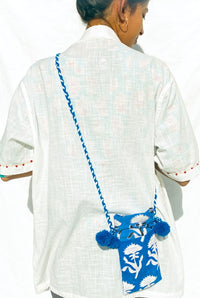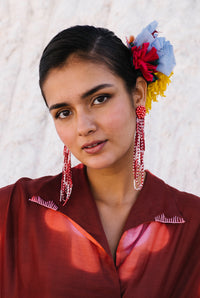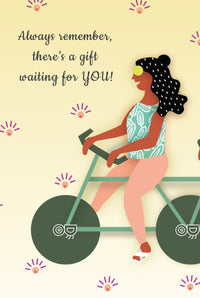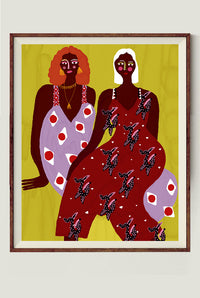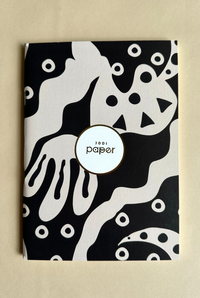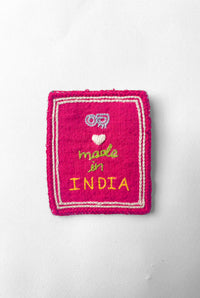Art and Representation
HERE COMES THE ART

We’d been keeping a close eye on Rajiv Menon’s work for a while, and when he launched his own gallery, it truly caught our attention. Ever since, we’ve been loyal fans of both his art and his super-cool Instagram feed. We were eager to sit down for a chat with him—if not in person, then at least through the magic of the internet. While we never got the chance to meet Rajiv in person for this feature, we could feel his warmth and humility in every conversation we had.
A Texas native who swapped cowboy boots for a PhD on the East Coast, Rajiv discovered his passion for the arts at NYU. After nearly a decade in television, he realised that art was calling his name louder than anything else. He jumped into collecting art to support the incredible artists he encountered during his travels, and last year, he took the leap and launched Rajiv Menon Contemporary. This isn’t just any gallery; it’s one of the few in the US dedicated to celebrating South Asian art, aiming to shine a light on a scene that’s often overlooked.
When he’s not busy curating exhibitions or connecting with artists, you can catch him wandering through new cities around the globe, soaking up inspiration and collecting stories that add to his love for art and culture.
We're about to have a fun chat with him about his love for art, and trust us—you’ll be as obsessed with art as he’s made us! Rajiv Menon Contemporary, LA
Rajiv Menon Contemporary, LA
RAJIV: I love Texas because it’s such a multifaceted place. While I grew up in the suburbs, which could at times feel a bit conservative (as one would expect in Texas), Houston itself is a surprisingly global place. It’s a city that’s been welcoming of immigrants and refugees. It has industries that attract talent from all over the world. So I had this interesting contrast between my town, which felt very Americana, and the city, which was so cosmopolitan and international.
I also spent substantial time in India as a child, so I think much of my upbringing was shaped by constantly shifting cultural contexts and having to adapt to new environments.
JODI: What's the most unexpected thing you've discovered about living in LA that you didn’t anticipate before moving there? We’re sure LA is full of hidden gems—what’s one spot that feels like your personal retreat?RAJIV: I think people immediately assume Los Angeles is all about Hollywood and entertainment, and while this can often feel true, there’s so much more depth to the culture. California has always been a hub for arts and architecture, and I’m constantly stumbling upon incredible spaces that feel like artworks themselves.
I love visiting the Fowler Museum, an absolutely stunning museum space that’s becoming a really significant platform for global creativity in Los Angeles. The exhibitions are not only brilliant, but the building itself is a beautiful example of Southern California architecture. It’s a perfect place to spend a quiet afternoon.  Rajiv wears our Shevanti handloom shirt
Rajiv wears our Shevanti handloom shirt
RAJIV: I arrived in New York at age 21 for my PhD, and I was wide-eyed and eager to absorb all the culture I could. I went to everything: film festivals, plays, fashion shows–I was completely floored by the level of creativity and ingenuity in all its forms.
I used to love walking around Chelsea and just stumbling into galleries, which became a slow exercise in developing my palate. I unconsciously started to build a sense of taste, so it wasn’t a sudden moment of clicking but a slow burn. New York is one of the few cities that can provide that type of education.
RAJIV: My career trajectory sometimes feels like a series of hard pivots, but I actually believe that every stage of my life has built on what came before it. I started as an academic, and the process of getting my doctorate required that I think and write in a very challenging way, often focusing on very esoteric and dense material. But after finishing my degree, I found myself working in marketing and entertainment, fields that demand accessibility and commercial appeal. It was a very concerted effort to not reject or unlearn my previous training but to build new skills to speak to wide audiences. In many ways, I feel like my work in art splits the difference between these two worlds. I have to engage with challenging work, but I also have to translate art for audiences that might be newer to the space.
Each time my career has evolved, it has felt like learning a new language, and while that can be an adjustment, I love the experience of gaining fluency in a new space.
RAJIV: I started to see the seeds of a major cultural movement around South Asian artists in the US, and I wanted to contribute and participate in any way I could. There were artists I had been following for some time, like Asif Hoque, Hiba Schahbaz, and Chitra Ganesh, and I was so excited to support artists who were reshaping the culture before my eyes.
My collecting practice has definitely widened, and I’m no longer limited to just South Asian artists. I want my collection to capture the mood and aesthetic of our present moment, and I want to be able to gain insight into this period in history through artwork.
 Rajiv wears our Banyan Appliqué shirt
Rajiv wears our Banyan Appliqué shirt
RAJIV: It’s one of the biggest leaps I’ve ever taken in my life. In many ways, I’m an outsider to the art world in LA–I didn’t have much of a presence or profile and had to rely heavily on word-of-mouth to get off the ground. I’ve been so surprised and moved by the warmth and support my peers in the art world have shown me.
JODI: Why do you think conversations about South Asian art are more relevant than ever? Have you seen a shift in how Western audiences engage with and perceive it?
RAJIV: For many Western audiences, South Asian art is largely limited to antiquity. You can go into many art museums in North America and Europe and get the impression that South Asia only exists in the past. While pre-modern art is an essential part of our culture, it’s also very important that we see current aesthetic expression from the subcontinent and diaspora.
So many of the themes that define our global cultural moment–migration, climate change, political tumult, urban alienation–are epitomised in the subcontinent. Not only are artists from South Asia presenting entirely singular viewpoints, but they’re also leading a shared global conversation.
South Asia’s art landscapes are growing so rapidly. There are so many new museums, foundations, fairs, and platforms emerging in the region, and these are all becoming major players in the global art world.  Rajiv wears our Banyan Appliqué shirt
Rajiv wears our Banyan Appliqué shirt
RAJIV: I see the beginnings of a serious art tourism market in South Asia, especially with the rising prominence of major biennials and summits in the region.
In the US, I’m really excited to see South Asian art entering conversations with art from other parts of the Global South. In Los Angeles, I’ve seen a really interesting dialogue between South Asian and Latin American art, with collectors finding common points of cultural and aesthetic resonance.
JODI: You mentioned you love travelling! How has your passion for travel opened your eyes to different cultures and shaped your interests?RAJIV: Travel requires you to be somewhat of a relativist and to understand a place on its own terms. It demands open-mindedness and a sense of adventure, and these are all traits that have shaped my approach to art.
JODI: What’s the most surprising thing you’ve learned from the artists you’ve met, and what do you find most rewarding about connecting with them during your travels?
RAJIV: I love seeing how an artist takes influence from a new place. This summer I had the chance to spend some time in the Netherlands, and met many artists who had come from elsewhere to work in Europe. I love seeing how the influence of Dutch art seeped into their work–it was like watching culture develop and evolve in real-time.
JODI: Art is truly a catalyst for change. How do you choose the artists you showcase in your gallery?RAJIV: For the first year of the gallery, I was conscious of needing to show a wide range of artists, as I had to shape and develop a completely new market. While the practices I feature are quite diverse, I need the artwork to provide a strong emotional and intellectual response. If I organically find myself with a lot to say in response to the work, I know it’s a good fit.
 Rajiv wears our Shevanti handwoven shirt
Rajiv wears our Shevanti handwoven shirt JODI: What’s the most interesting piece of art you’ve collected, and what’s the story behind it?
RAJIV: I have a collage work by Huma Bhabha that spoke to me on so many levels. Her work not only evokes feelings of alienness and foreignness, which are so prominent in the diaspora, but she also references so much of the pop culture I consumed as a kid.
JODI: If someone wants to dive into curating, what’s one piece of advice you’d hand them?RAJIV: Your curation should have a central thesis you want to convey–it’s not enough to simply group people based on common origins or identity, you need to have a deeper perspective over what these artists are communicating together.
JODI: Are there any contemporary artists or filmmakers whose work resonates with you on a personal level? What draws you to them?
RAJIV: The list is endless: Bhasha Chakrabarti, Anoushka Mirchandani, Sanie Bokhari, Noorain Inam, Salman Toor, Melissa Joseph, and Caleb Hahne Quintana are some visual artists who deeply speak to me. They each illuminate their own experiences of the world in ways that give me new visual language to think about my own life.
Coming out of the world of entertainment, there are so many filmmakers who similarly shape my worldview: Sofia Coppola, Claire Denis, Luca Guadanigno, Terrance Malick, Dario Argento, and Adoor Gopalakrishnan have all given me new aesthetic frameworks for thinking about the world.
JODI: If you could experience any decade in music, film, or any art movement, which would you choose, and what intrigues you about it?RAJIV: The '60s seemed like such a utopian time for creativity–the avant-garde and new-wave aesthetics of the time showed so much possibility.
 Rajiv Menon Contemporary, LA
Rajiv Menon Contemporary, LAJODI: Your Instagram really shows how connected you are to your Indian roots—be it festivals or Bollywood! How has that influenced your inspirations?
RAJIV: Art, film, and fiction were so important in navigating a life that felt split between India and the US. Connecting to my culture allows me to feel like I can exist in multiple places at once. I think I’m constantly searching for forms of culture that forge these types of connections.
JODI: If you could only watch one Bollywood movie for the rest of your life, which one would you choose?
RAJIV: Not Bollywood, but Kollywood- the 1998 Aishwarya Rai Tamil film 'Jeans' is an all-time favourite. It’s an accidental masterpiece–hilarious, campy, bizarre, surreal, and yet, at times, stunningly beautiful. It’s a movie that’s completely unconcerned with self-seriousness or the approval of a Western audience. I have such a fun time every time I watch it, and it also features an absolute no-skip soundtrack by A.R. Rahman. I think it's a movie that really shaped my capacity for the offbeat as a kid.
RAJIV: Fashion and art are always in conversation for me. I love thinking about how one can communicate their personal sense of aesthetics through clothing. I want my wardrobe to translate my personality through textiles and silhouettes, and I find it to be a really important form of creative expression. I love how fashion, like art, can foster intercultural dialogue.
JODI: Since you champion so many Indian homegrown brands, how do you think local craftsmanship influences your fashion choices and personal style?
RAJIV: Working with textile artists has given me so much appreciation for how things are made. Craftsmanship is such an important expression of humanity, and India has some of the most significant craft traditions on earth. These are generationally taught skills, and supporting artisans is really important to make sure these forms survive the test of time. I love purchasing from brands that have this as part of their mission, because I know wearing their clothes extends beyond pure consumerism. It’s about supporting a broader culture. I love knowing the story behind the material of the clothes I wear, and Indian brands are leading this effort.
JODI: And lastly, what’s your favourite JODI piece to wear?RAJIV: I love the Shevanti Handwoven shirt–it’s such a versatile piece–I’d feel totally in place walking down the street in LA, or at a Mehndi ceremony. I love clothes that can travel across contexts, and this is such a great example!
Muse: Rajiv Menon
Photographer: Simran Malik

